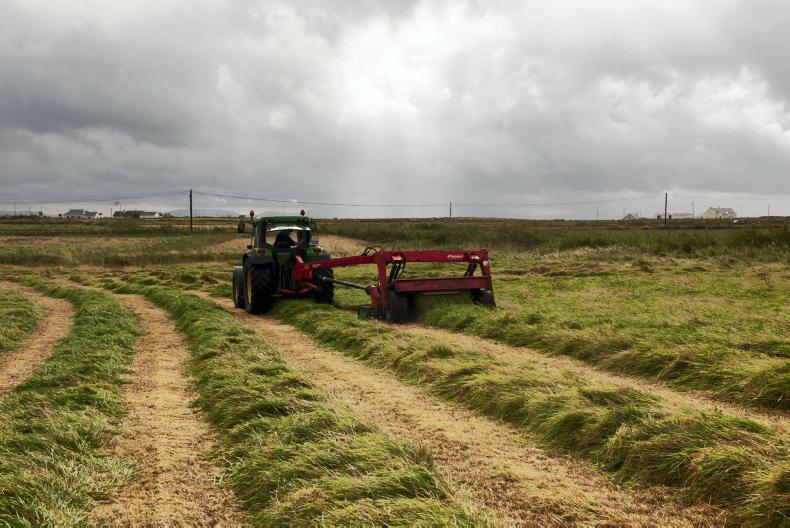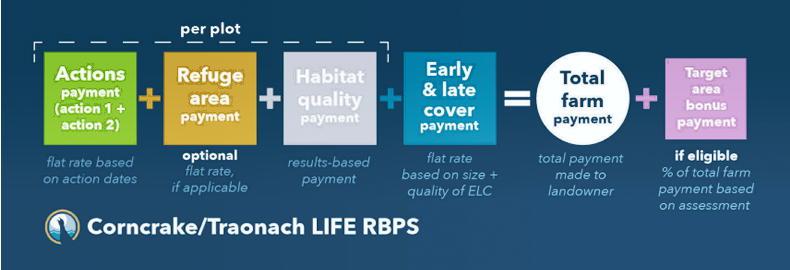More farmers and landowners are being sought to take part in the €5.9m Corncrake LIFE project.
The scheme was officially launched this Friday in Donegal, but has been underway since last year.
Last year, the scheme ran a phased pilot with 47 farmers taking part. The target is for the scheme to have 1,000ac under “corncrake management”, scheme project manager Dr John Carey told the Irish Farmers Journal. Almost 400ha has been reached already.
“It’s a miracle that the bird has held on in Ireland at all,” he said
Farmers, private landowners and the National Parks and Wildlife Service (NPWS) are all pulling in the same direction, he said.
“There’s a different approach for this scheme. Whether the bird arrives or not, farmers will be rewarded for habitats [they have created under the scheme].
“The corncrake is a grassland bird of our grandparent’s generation, when farms were mixed and there was tillage, sheep, cattle and dairy in every parish,” he said.
Project areas
There are eight project areas in the scheme in Galway, Mayo and Donegal. These project areas are focused around designated Special Protection Areas (SPAs) for the corncrake, but also include non-designated lands which regularly host corncrakes. When combined, these areas maintain approximately 85% of Ireland corncrake population.

Corncrake-friendly mowing. Cutting the fields from the centre of the field towards the edges by leaving an uncut strip at least two metres wide around the field edges to provide an escape route for birds in Belmullet, Co. Mayo. \ Michael Mc Laughlin
The project refers to these areas as ‘corncrake catchments’:
1. Malin Head catchment.2. Fanad Head catchment.3. Meenlaragh to Marblehill catchment.4. Inishbofin and Inishdooey catchment.5. Tory Island catchment.6. West Donegal catchment.7. The Mullet catchment.8. Inishbofin, Omey Island and Turbot Island catchment.Actions and payments
The scheme is not a full results-based scheme, but a hybrid one – there are prescribed actions which farmers will be paid for and a results-based payment, which is determined by habitat quality.
One of the actions in the scheme is where farmers choose to close off their plot to stock. The earlier a farmer closes off their plot, the higher the payment. If a farmer closes off a plot on 1 January, the payment rate is €100/ha and if it closed off on 1 April the payment rate is €25/ha.
Another action in the scheme revolves around the time when farmers begin mowing or grazing.
If a farmer delays mowing until 15 September and is in an SPA, they will receive a payment of €300/plot or €175/plot outside of an SPA. If grazing is delayed until this date, the payment is €200/t in an SPA or €175/plot for farmers outside of an SPA.
Payments under this action are conditional on the active management of lands and where lands are not grazed or mown, payments may be curtailed or adjusted.
Under the habitat quality payment, there is a maximum payment rate of €350/plot – this payment is based on result on the scorecard and the date of action.
There are also supporting payments and a bonus payment, which farmers can qualify for.

How the payment under the scheme is calculated.
Corncrake
Corncrake numbers have declined by over 90% in the last 40 years. Its distinctive call was once heard all over the Irish countryside, but the modernisation of agriculture has wiped the birds out and they are now only found in the west and northwest of the country.
The Corncrake LIFE project will work to address the many complex issues in the birds’ remaining strongholds to ensure that communities, farmers and wildlife can co-exist without conflict.
More details on the scheme can be found here.
See more on the scheme in next week’s Irish Farmers Journal.
More farmers and landowners are being sought to take part in the €5.9m Corncrake LIFE project.
The scheme was officially launched this Friday in Donegal, but has been underway since last year.
Last year, the scheme ran a phased pilot with 47 farmers taking part. The target is for the scheme to have 1,000ac under “corncrake management”, scheme project manager Dr John Carey told the Irish Farmers Journal. Almost 400ha has been reached already.
“It’s a miracle that the bird has held on in Ireland at all,” he said
Farmers, private landowners and the National Parks and Wildlife Service (NPWS) are all pulling in the same direction, he said.
“There’s a different approach for this scheme. Whether the bird arrives or not, farmers will be rewarded for habitats [they have created under the scheme].
“The corncrake is a grassland bird of our grandparent’s generation, when farms were mixed and there was tillage, sheep, cattle and dairy in every parish,” he said.
Project areas
There are eight project areas in the scheme in Galway, Mayo and Donegal. These project areas are focused around designated Special Protection Areas (SPAs) for the corncrake, but also include non-designated lands which regularly host corncrakes. When combined, these areas maintain approximately 85% of Ireland corncrake population.

Corncrake-friendly mowing. Cutting the fields from the centre of the field towards the edges by leaving an uncut strip at least two metres wide around the field edges to provide an escape route for birds in Belmullet, Co. Mayo. \ Michael Mc Laughlin
The project refers to these areas as ‘corncrake catchments’:
1. Malin Head catchment.2. Fanad Head catchment.3. Meenlaragh to Marblehill catchment.4. Inishbofin and Inishdooey catchment.5. Tory Island catchment.6. West Donegal catchment.7. The Mullet catchment.8. Inishbofin, Omey Island and Turbot Island catchment.Actions and payments
The scheme is not a full results-based scheme, but a hybrid one – there are prescribed actions which farmers will be paid for and a results-based payment, which is determined by habitat quality.
One of the actions in the scheme is where farmers choose to close off their plot to stock. The earlier a farmer closes off their plot, the higher the payment. If a farmer closes off a plot on 1 January, the payment rate is €100/ha and if it closed off on 1 April the payment rate is €25/ha.
Another action in the scheme revolves around the time when farmers begin mowing or grazing.
If a farmer delays mowing until 15 September and is in an SPA, they will receive a payment of €300/plot or €175/plot outside of an SPA. If grazing is delayed until this date, the payment is €200/t in an SPA or €175/plot for farmers outside of an SPA.
Payments under this action are conditional on the active management of lands and where lands are not grazed or mown, payments may be curtailed or adjusted.
Under the habitat quality payment, there is a maximum payment rate of €350/plot – this payment is based on result on the scorecard and the date of action.
There are also supporting payments and a bonus payment, which farmers can qualify for.

How the payment under the scheme is calculated.
Corncrake
Corncrake numbers have declined by over 90% in the last 40 years. Its distinctive call was once heard all over the Irish countryside, but the modernisation of agriculture has wiped the birds out and they are now only found in the west and northwest of the country.
The Corncrake LIFE project will work to address the many complex issues in the birds’ remaining strongholds to ensure that communities, farmers and wildlife can co-exist without conflict.
More details on the scheme can be found here.
See more on the scheme in next week’s Irish Farmers Journal.








 This is a subscriber-only article
This is a subscriber-only article










SHARING OPTIONS: